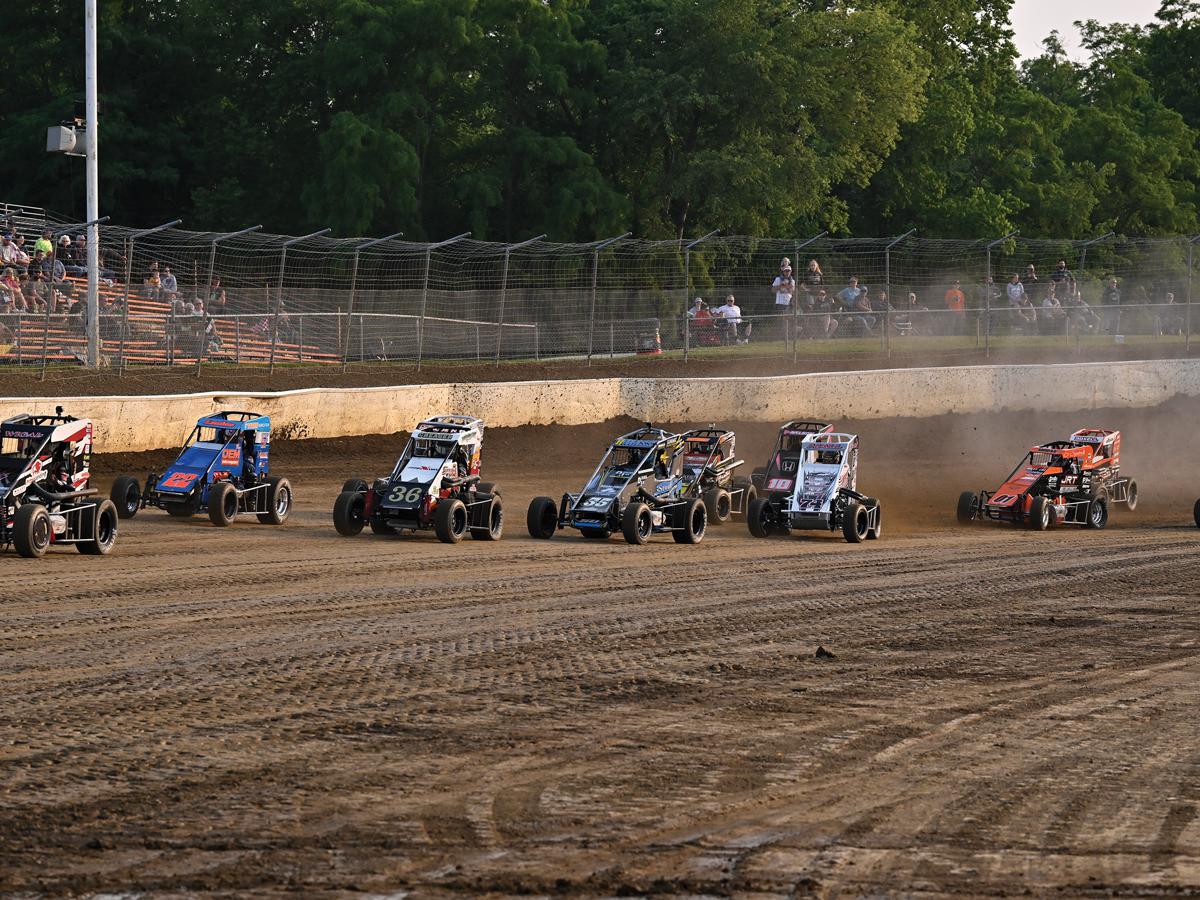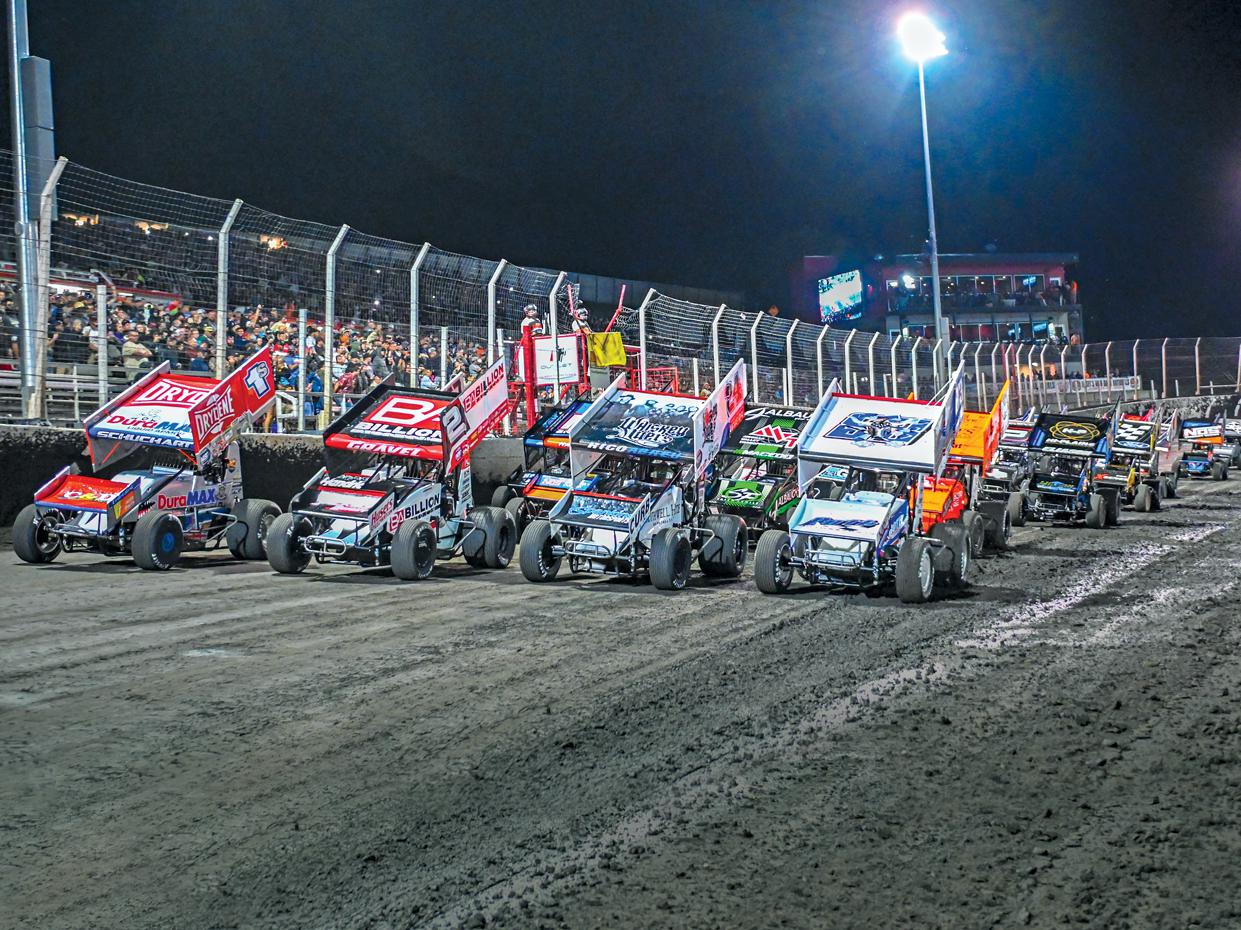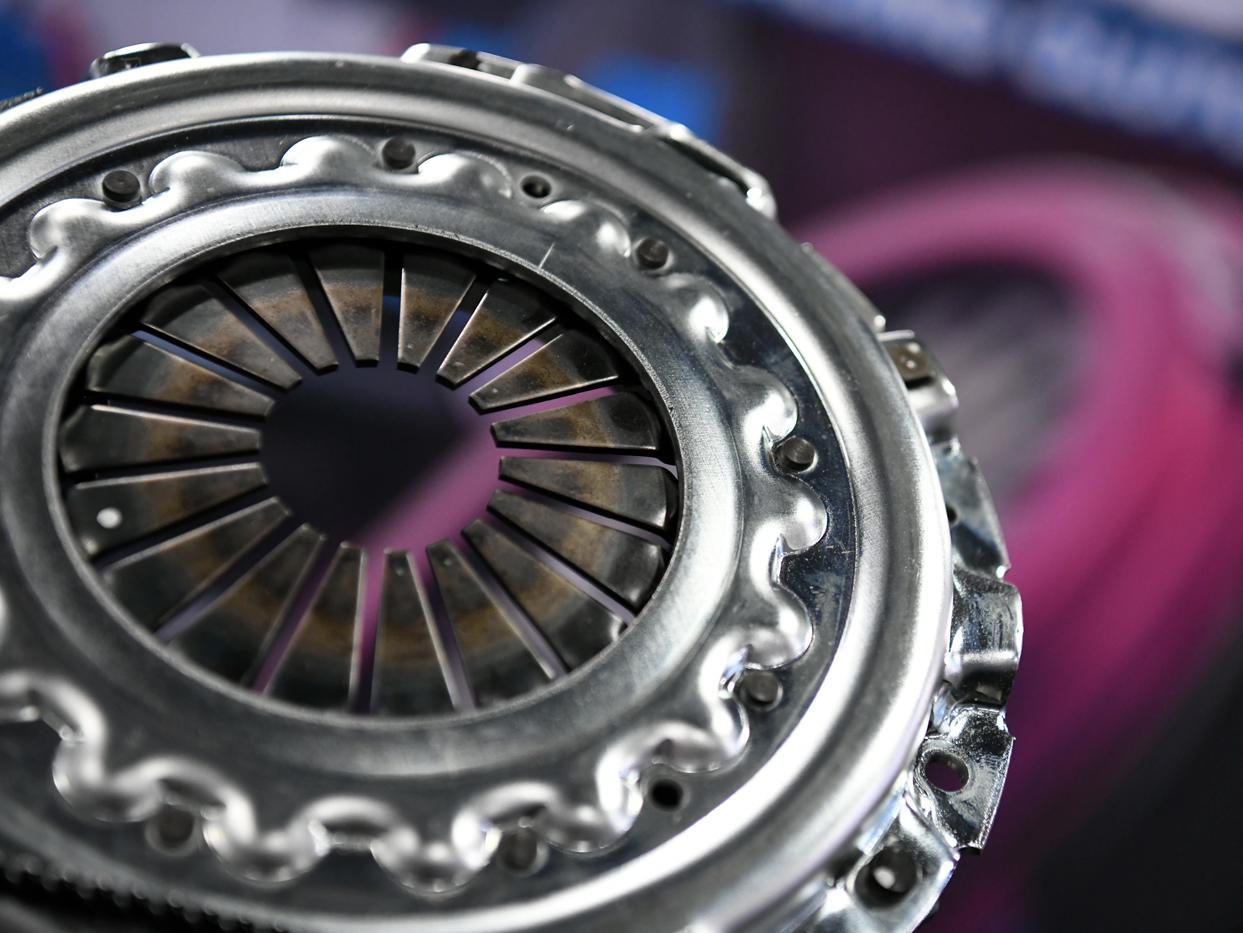Power Channels
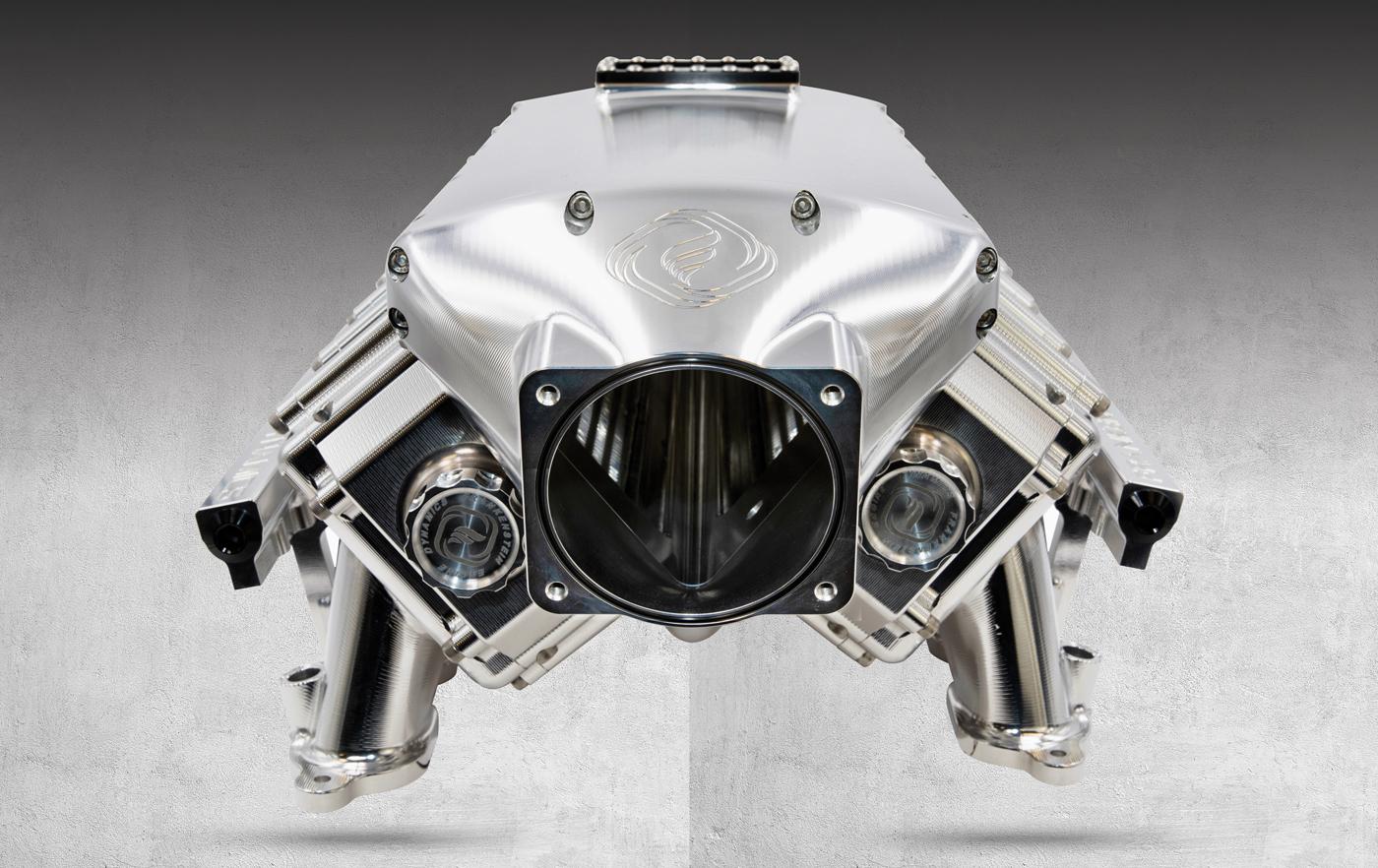
Photo courtesy of Frankenstein Engine Dynamics
Custom, purpose-built intake manifolds are still a priority for high-end racers, but serious development work for performance production intakes should resume after COVID-19 delays.
Mike Weinle of Weinle Motorsports in Cleves, Ohio, has worked with a Super Stock racer in Sweden to develop the induction system for his drag racing 440-cubic-inch six-pack Mopar. Rules allow a sheetmetal intake manifold, but the owner had a height restriction.
Weinle said most of today’s high-tech engines have found improvement in shorter runners and larger plenums. “But on this Super Stock car, it was a smaller plenum and longer runner that made it happy,” he noted, adding that he also morphed a round runner into an oval shape. “It was almost a 7-inch runner. It will not run down the track with a big plenum because the car is 3,800 pounds. If the plenum is too big, you’ll lose your acceleration.
“We don’t build much stuff like that—a three-deuce tunnel ram—but I’ve done something like five manifolds for him over the years,” continued Weinle. “You’re always trying to build something better. We’ve ended up 10 or so horsepower better each time, but it’s trial and error. Luckily, the last three have been better each time.”
A little better each time. That’s a game plan much of the intake manifold industry has been following for the past 18 months. Sure, there are one-off custom fabrications for specific racing applications, and sophisticated performance designs are finding a way into catalogs (see sidebars). However, production concerns have sidelined many R&D projects, so much of the development work is focused on incremental improvements.
“From last year to this year, we’ve been so busy and so far behind that we’ve had no time for development work,” said Mark Fretz of Brodix, Mena, Arkansas. “We’re always fine-tuning and refining what we have as we find little things that customers need or discover things that work.”
“I’ve had my hands full trying to keep up with what we have right now,” agreed Bill Mitchell of Bill Mitchell Products (BMP) in Edgewater, Florida. “We’re doing minor tweaks here and there.”
“We’ve got a lot on the drawing board,” added Eddi Pinegar of Trick Flow, Tallmadge, Ohio. But a number of complications, including COVID-related backlogs, has delayed new product implementation. “Plus our orders have gone through the roof, so we really can’t develop anything. We probably won’t have anything new coming out until next year.” Trick Flow also lost its foundry, “so we had to go to a different one, and that’s a whole hassle in itself.”
If there was one massive hangover for the performance industry from the COVID experience, it was all the production setbacks that manufacturers had to overcome. Numerous “mom and pop” foundries that served racing interests had to shut down during the pandemic because of worker shortages and trouble obtaining raw materials.
As the manifold industry found new foundries to work with, new tooling had to be made to complement the intricacies of that foundry’s process. That meant test runs, inspections and tooling adjustments. However, with fewer foundries operating, the workload doubled for some. What normally would be a three-week turnaround to test tooling or start a production run turned into a three-month ordeal or even longer.
“You’re looking at another year to get an intake manifold out to the customers that you introduced a year earlier,” said one company official who wanted to remain anonymous.
The labor problem was so severe that another company had to gather up a posse of its own shop employees and fly them to a foundry to pour the castings in order to meet its orders because the foundry had lost so many workers.
On the upside, racing has resumed, fans are returning, and big boost is still making rousing headlines, especially at the drag strip.
Driving The Market
“They’re going up to 75 pounds of boost now, so that really has changed intake manifolds,” said Keith Wilson of Wilson Manifolds, Fort Lauderdale, Florida. “We need to strengthen them and improve distribution, because they’re trying to jam so much air in there. The velocity coming in is really creating havoc on distribution. Everything packs up in the back. Now you have to put in burst panels in case there’s a backfire. You’ve also got to have two injectors for each cylinder to supply the sheer amount of fuel they need. Just a lot more goes into the design with boost.”
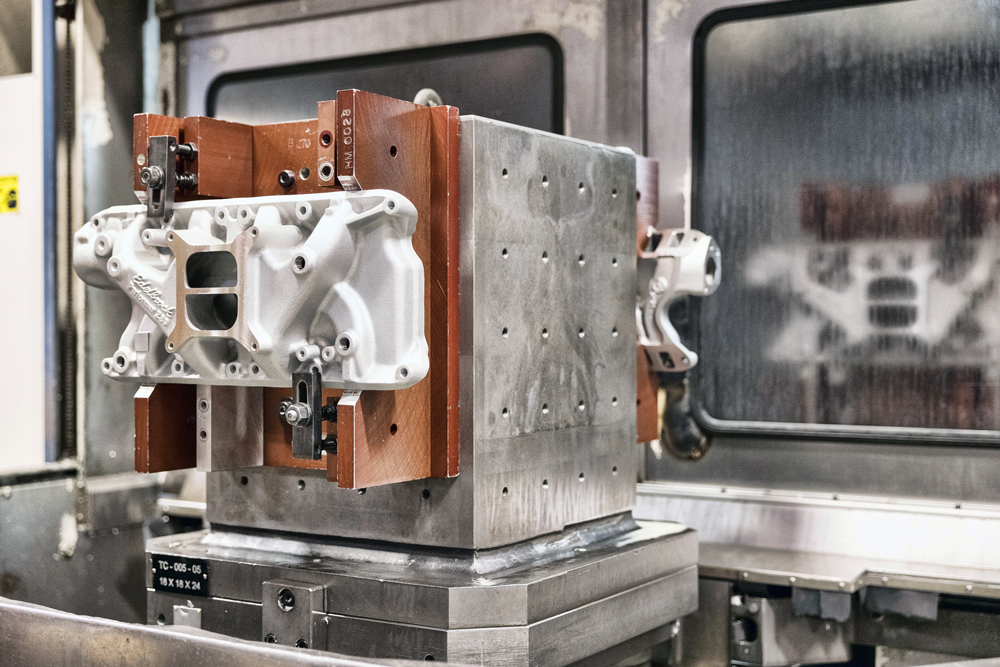
“Edelbrock Victor-style manifolds used in conjunction with one of our EFI elbows has always been a boost-loving combination available for many different engines,” noted Brent McCarthy of the Edelbrock Group, Olive Branch, Mississippi. “If you want more runner length, plenum volume, and a look that can’t be beat, our FAST HR series polymer manifolds for LS engines are the way to go. We have tested them to well over 45 psi, so leakage is not an issue.”
The upward trend in boost has been driven by a few factors, including reasonable cost per horsepower, the Outlaw drag movement and, most importantly, huge strides in electronic fuel injection and fuel management. Intake manifold design followed these trends with dedicated designs, or manufacturers found ways to adapt existing product.
Improvements in bolt-on, throttle-body EFI systems have also allowed manufacturers to continue development of carburetor-style intake manifolds.
“It looks like a carburetor, especially when you have the air filter on, but you have the modern conveniences,” said Tim Torrecarion of Air Flow Research, Valencia, California. “We have dual-plane and single-plane intakes, and with the popularity of these EFI conversions where you still have the old-school look, I think this trend will be around for several years.”
Currently in AFR’s development plans is a line of big block Chevy intakes to fit conventional cylinder heads. The company offers a single-plane intake with a 4500-series footprint designed to complement AFR’s 18-degree Magnum BBC heads.
“But that’s not something your average street guy would put on a 454,” noted Torrecarion. “So, we’re tossing around ideas for a conventional intake: how many and what versions as far as carb heights and applications.
“At the end of the day, it’s all about sales and market potential,” summed up Torrecarion. “That’s why we have three manifolds for the small block Chevy. We have growing SKUs for small block Ford and even our big block Ford. Now, the next one in line is going to be the conventional big block Chevy. I think we have three designs to give us the widest coverage.”
“The Ford Cleveland-head small block is crazy because we do a ton of carburetor and fuel-injected manifolds for them,” said Pinegar. “We also have a dual-carb tunnel intake for the Ford FE that’s coming back out. We introduced that earlier and it went over really well. Then we lost our foundry.
“No one makes that FE intake any longer,” continued Pinegar. “When we’re at the shows, we listen to what people are asking for. It seems they like the FE. We did a single-carb intake and sold more than we expected. Basically, it looks like the factory medium-riser intake, but we redesigned the plenum and runners to get more power.”
Carbureted small and big block Chevy applications remain strong sellers at BMP. “More and more guys are getting small block intakes for different applications, especially circle track,” said Mitchell, noting that he’s been able to keep orders filled and is picking up ground where other suppliers have struggled to meet demand. “We have a couple of marine part numbers for the big block Chevys, and they love those.”
The BBC marine intakes feature cast-in bronze water jackets to reduce corrosion in salt water environments. “Season to season, they had to change manifolds because they all rotted out,” said Mitchell.
Carburetor vs. EFI
In the end, there will be pros and cons to the carb vs. EFI debate.
“With increases to displacement and rpm, the same principles to manifold design apply,” explained McCarthy. “It is easier to execute ideal runner lengths and areas in an EFI manifold than a carb manifold. But carbureted manifolds still have the benefits of a cooler air charge and more time for the fuel and air to mix.”
Even high-tech engines like the Gen V LT, which was designed with direct injection (DI), have users who prefer carburetors, or at least more conventional port injection. Mast Motorsports in Nacogdoches, Texas, has a two-piece carburetor intake for the LT1 and LT4, which requires plugging the DI holes in the cylinder head. The intake could also be used to build a conventional port-injected EFI system. But why would a customer take a theoretical step backwards in engine efficiency?
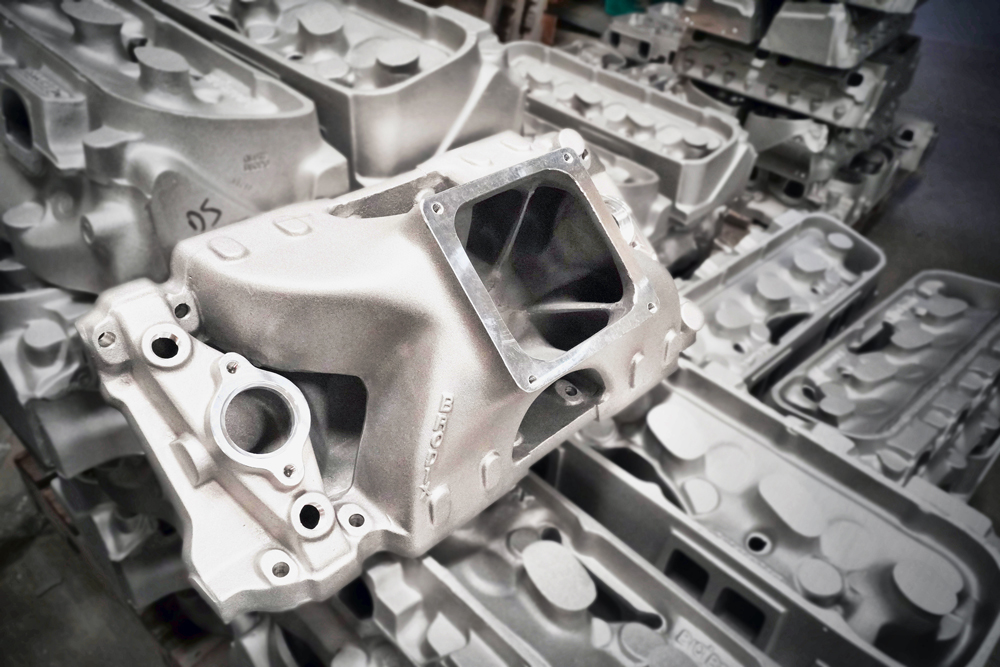
“DI is harder to manage for the guy who wants to stick with the old school and is comfortable tuning it,” said Mast Motorsports’ Perry Kiritsy. “He doesn’t necessarily know the new Gen V system. It allows you to utilize the Holley Dominator or Terminator systems.”
Mast has three lines of intakes that appeal to a wide range of users: Mozez (the all-out racing product), Black Label and Factory Mast. The company recently updated its popular Mozez LSX intake, made from a hybrid construction of a cast lower base with a billet lid and throttle-adapter.
“We changed the intake port layout from our first Gen I design, and it has a little bit of a different port shape,” said Kiritsy. “It has an increase in plenum volume, and we offer it with the burst plate now. You can get two sets of injectors, and we do 105-mm and 125-mm snouts. The market really needed that for grudge racing, specifically the guys who run 50 pounds of boost. They tend to split welded manifolds, and we came out with a really robust casting.”
In addition to developing product for the Gen V platform, Mast is also targeting a new Ford product.
“Godzilla is the buzzword of late,” said the company’s Jason Youd of the new Ford 7.3-liter V8. “We have a CNC-ported cylinder head for Godzilla, so we’re working on an intake. The factory one is pretty darn good, though, so it’s hard to make it better.”
Cylinder head development is always a driving force for intake manifold manufacturers. Brodix will release a new cylinder head in the near future but is not disclosing the application or target market.
“I have to be really careful on this one,” noted Fretz. “Yes, there will be an intake manifold that has to be designed specifically for that particular type of head when we get it. I don’t know that it will be ready for the PRI Show this year, but that is the hope. We’ve had the prototypes on the flow bench and in wet flow. They’re doing pattern work on it now, but with all of the issues within the industry, it’s hard to find time to get all the R&D work done.”
To meet the increasing airflow needs of large displacement engines and boost applications using the big block Chevy, Brodix has developed its BM2018 and BM2028 series of intake manifolds. Designed for big displacement, high rpm (4,000 to 8,500) applications, these single-plane intakes have large, contoured plenums to help provide the best signal to the carburetor or handle boost.
“They can be port matched to either oval or rectangular port,” said Fretz. “It’s a larger plenum, so if there’s any type of power adder or a large cubic inch with high air demand, that’s the manifold we would run.”
Design Techniques
Many of the leading intake manifold manufacturers design their products using old-school techniques, such as hand-porting prototypes by experience, measuring flow-bench results and crunching the numbers by hand. Others have adapted computer design and analysis tools.
“It’s a combination of all the above,” said Jesse Meagher of Frankenstein Engine Dynamics, Weatherford, Texas. “No single tool really gives you the whole picture. Based on years of dyno and track testing, we have our own formula for what we like in plenum volume. That may change depending on rpm goals, engine displacement and whether it’s naturally aspirated or turbocharged.
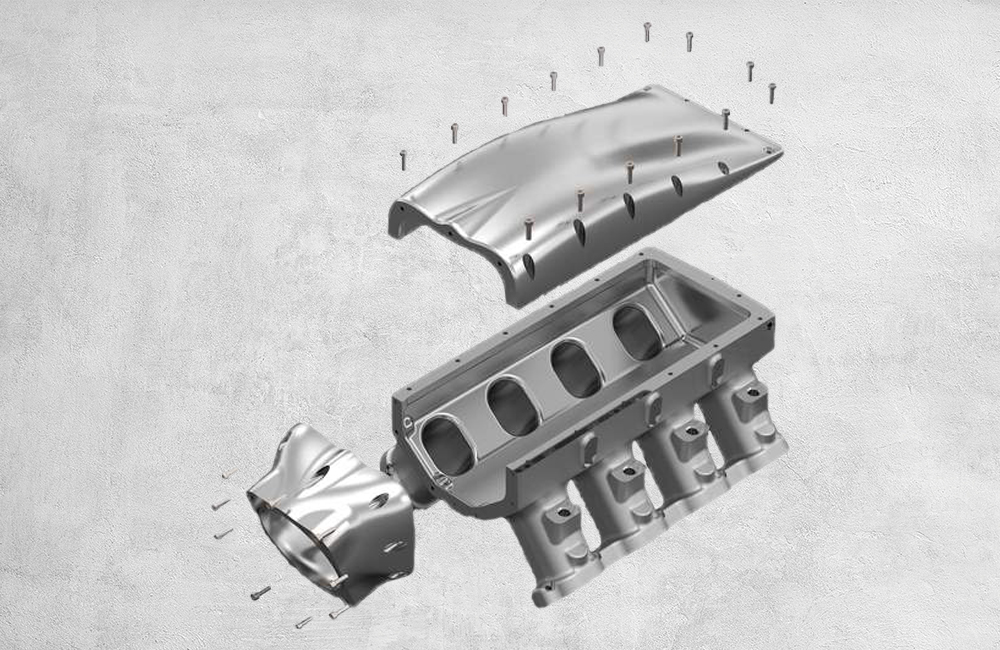
“Then we look at runner length and use some of the more old-school calculations, again dependent on rpm range,” continued Meagher. “The icing on the cake for us then is the CFD (computational fluid dynamics). That lets us look at what’s happening dynamically throughout a complete combustion cycle, taking into account all the valve and cam-timing events. Then we look for distribution issues that we can correct. We’re not only looking to get equal distribution across all of the runners, but we’re also looking to optimize the velocity of the air in each different portion. It’s really a combination of those three factors that leads to our successful manifolds.”
“For us, it’s every bit of experience,” countered Wilson. “We’ve worked with companies on CFD. It’s a good tool, but it was like a flow bench. It’s not everything. It all depends on the information you put in.”
With so much pent-up enthusiasm to develop new production intakes, the future will be interesting for the induction market. And there will still be a few specialty intakes that will be curious in nature, in addition to engineers pursuing fresh concepts.
“We build old-style manifolds,” said Weinle. “Right now, we’re working on a blower manifold for a 302 Ford with D3 heads.”
“Once in a while, designers get to work on a fun and radically different idea,” concluded Edelbrock’s McCarthy. “We had several pallets of prototypes in Torrance that even with the highest of hopes did not run well enough to see production.”
Coyote Boost
–
Divide and conquer. That’s the strategy behind the Bulldog intake from Frankenstein Engine Dynamics of Weatherford, Texas, that’s designed for Ford Coyote applications.
“The original inspiration was our Iceman manifold that we make for LS and LT platforms,” explained Jesse Meagher. “That uses a single, large inner core. Due to packaging restraints, we really scratched our heads trying to get a large enough core to support the horsepower goals.”
The team penciled out the math and discovered two smaller air-to-water cores—one for each bank of cylinders—would meet the tight packaging restrictions and cool down the intake charge.
“We’re seeing more and more ProCharger style builds, especially on the race car side” added Meagher. “The street car side is still dominated by turbos. Our Coyote line is where we’re really trying to design groundbreaking product.”
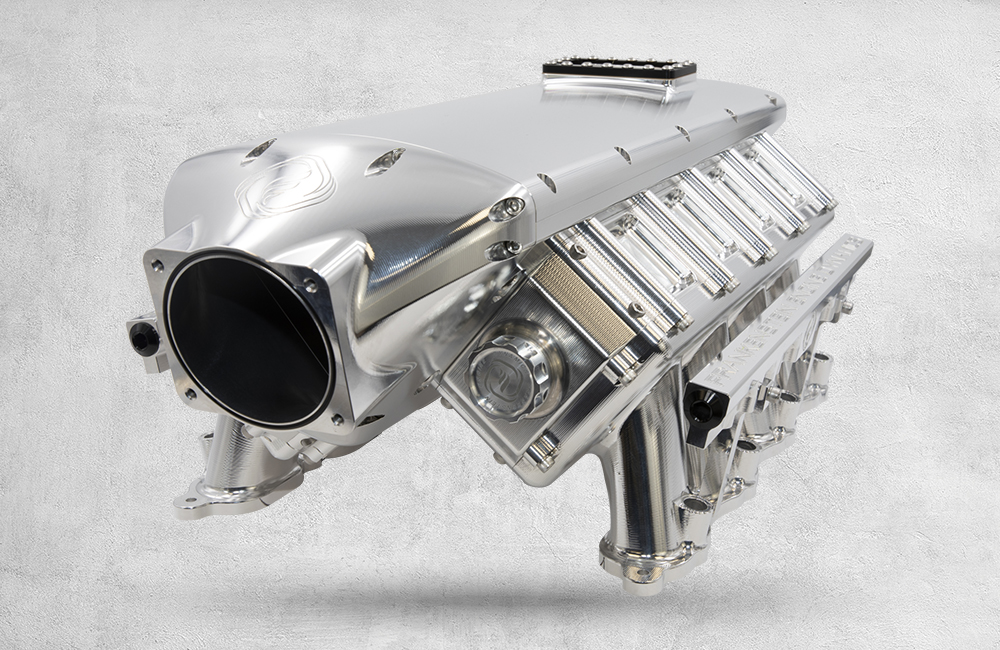
Constructed from 6061 billet aluminum, it’s available with single or dual injector bosses and comes complete with an SFI burst panel and fuel rails. The Bulldog can be ordered in natural finish or black anodized.
“Billet has a number of advantages over castings,” stated Meagher. “The raw material itself is inherently stronger, and it’s more machinable. Also, there’s tens of thousands of dollars needed to invest in tooling for a casting—especially for a product that may not be as popular as we think it should. So, there’s far less risk in billet.” —Mike Magda
Feeding 3,000 Horsepower
–
Wilson Manifolds of Fort Lauderdale, Florida, built a custom billet intake for Jerry Groves’ LS-powered Cadillac CTS-V drag car. YouTube videos show this car making 3,000-plus horsepower on a hub dyno.
“They wanted max horsepower and the best distribution,” said Keith Wilson. “A lot of people in drag racing overlook distribution, thinking that you’re running only a few seconds, but it is critical. If you’ve got your engine on kill and one or two cylinders are way off, you can only tune around the worst cylinder.”
The intake was designed with Wilson’s new 123-mm Hi-Boost throttle body that will seal up to 100 psi of pressure.
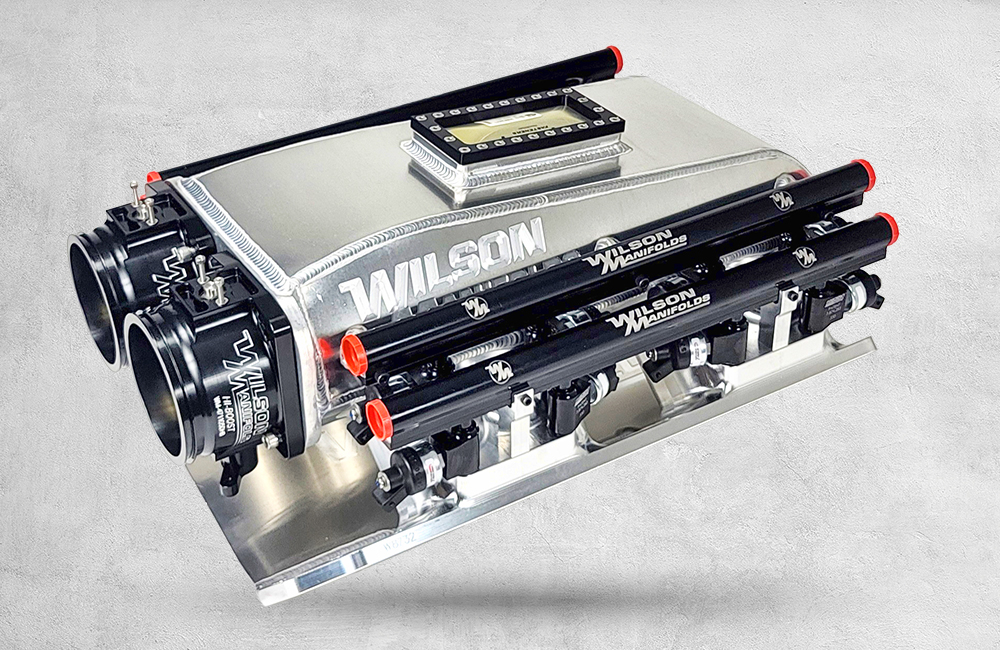
“Some of the Pro Mod guys will pick up two pounds of pressure by getting away from leaks in the throttle body,” noted Wilson. “We use a 5/8-inch shaft that is much more robust. The blade is constructed out of 70-series aluminum and cut on a taper, so it’s very aero. We lost no flow even though we went to a much bigger shaft.”
With twin turbos providing the boost, three injectors per cylinder were needed to supply enough methanol to the engine. Two injectors are fed by the lower fuel rail, and a single injector is fed by the upper rail.
“Three injectors give him more tuning flexibility and a small droplet size to keep a sharp tune,” said Wilson.
The manifold is machined from 6061 billet aluminum. Wilson said the design elements leverage past experience. “The idea was simply to make as much horsepower as possible.” —Mike Magda
IR Dynamics
–
Built for a wide range of performance applications using GM LS engines with cathedral-port cylinder heads, the FAST LSXHR intake manifold features adjustable-length individual runners (IR) so racers can find the ideal tune.
“The LSXHR is designed to be a tunnel ram-style intake manifold, ideal for generating maximum power in boosted and naturally aspirated engines,” said Chris Potter of the Edelbrock Group, Olive Branch, Mississippi. “It’s rated for up to 45 psi of continuous pressure.”
The lightweight polymer construction is durable and eliminates power-robbing heat soak that can affect aluminum intakes. The removable, reversible top allows for forward- or rear-facing throttle body installations. It also gives access to the individual intake runners that can be swapped out with different lengths.
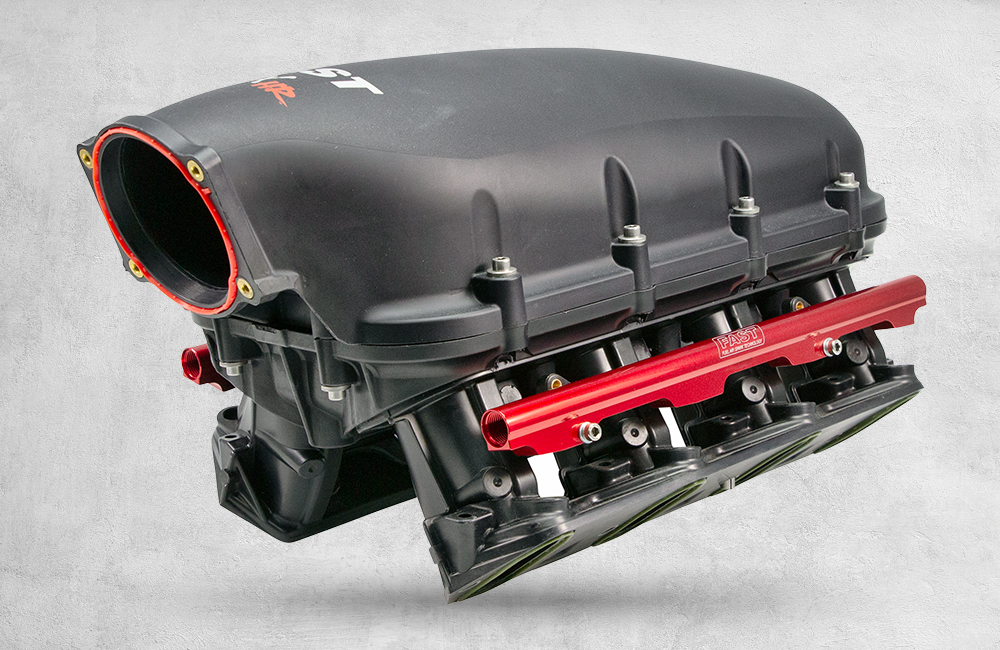
“The LSXHR manifold ships with the standard ‘long’ velocity stacks, and we offer ‘medium’ and ‘short’ stack options that can be purchased separately,” noted Potter. “This allows interchanging of the various runner lengths so racers can experiment with finding which combination makes the most power in their application.”
Other features include dedicated fuel rails, a fuel-injector angle optimized for ideal atomization from the spray pattern, two nitrous bosses per cylinder and a mount pattern for a 103-mm throttle body that can be bored out to 105 mm. The HR is also available for LS3 rectangular port and LS7 raised rectangular port applications in addition to the cathedral port.
“The design was fairly straightforward, as much of the envelope followed that of the LS3 and LS7 versions of the LSXHR,” said Potter. “The lower plenum of the manifold is unique to the cathedral port version to ensure optimal flow and performance with the different port shape. A different fuel rail was also required to ensure optimal position for the fuel spray toward the back of the valve.” —Mike Magda
SOURCES
–
Air Flow Research
airflowresearch.com
Bill Mitchell Products
billmitchellproducts.com
Brodix
brodix.com
Edelbrock Group
edelbrockgroup.com
FAST
fuelairspark.com
Frankenstein Engine Dynamics
frankensteined.net
Mast Motorsports
mastmotorsports.com
Trick Flow
trickflow.com
Weinle Motorsports
weinlemotorsports.com
Wilson Manifolds
wilsonmanifolds.com
 MEMBERSHIP LOGIN
MEMBERSHIP LOGIN JOIN PRI
JOIN PRI
